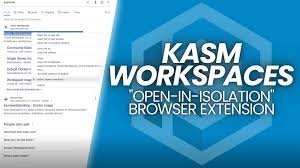
kasm workspaces
Introduction to Kasm Workspaces
In an age where remote work, cybersecurity, and digital transformation are top priorities, organizations are increasingly searching for solutions that combine security, flexibility, and ease of use. Kasm Workspaces has emerged as one of the most innovative platforms in this space. It provides a containerized streaming platform that delivers desktops, applications, and web services directly to users through their browsers. Unlike traditional virtual desktop infrastructure (VDI) systems, which can be expensive and complex, Kasm Workspaces leverages modern container technology to simplify deployment while maintaining strong security and performance.
The Concept of Containerized Workspaces
To fully appreciate the value of Kasm Workspaces, it’s important to understand the concept of containerization. Unlike virtual machines, which require an entire operating system for each instance, containers are lightweight environments that share the host system’s kernel while keeping applications isolated. This makes them faster to deploy, more resource-efficient, and highly scalable. Kasm Workspaces applies this principle to deliver desktops and applications. When a user logs in, the system spins up a containerized workspace on demand, streaming it securely to the browser. Once the session ends, the container is destroyed, eliminating persistent attack surfaces and reducing the risk of data leakage.
Key Features of Kasm Workspaces
Kasm Workspaces offers a wide range of features designed to meet the needs of modern organizations.
Browser-Based Access
One of the standout features is that users only need a web browser to access their workspace. There is no need for heavy client installations or complicated configurations, making it accessible across devices and operating systems.
Security-Centric Design
Security is at the core of Kasm Workspaces. By isolating each session in a disposable container, the platform prevents malware from persisting and ensures that sensitive information does not remain after a session ends. Features like end-to-end encryption, multi-factor authentication, and role-based access controls further enhance security.
Flexible Workspace Options
Kasm supports a variety of workspace types, including full Linux desktops, Windows desktops, individual applications, and secure web browsing environments. This flexibility allows businesses to tailor solutions to specific use cases.
Scalability and Automation
Built on modern DevOps principles, Kasm Workspaces integrates seamlessly with container orchestration systems such as Kubernetes and Docker. This enables IT teams to scale up or down quickly, automating resource allocation based on demand.
Customization
Organizations can customize workspaces with pre-installed software, security policies, and branding. This makes it ideal for companies that want to deliver a consistent experience to employees or customers.
Use Cases of Kasm Workspaces
The versatility of Kasm Workspaces makes it useful across multiple industries and scenarios.
Secure Remote Work
For organizations with distributed teams, Kasm provides a secure and efficient way for employees to access corporate resources from anywhere. Since workspaces are streamed to the browser, company data never leaves the server, reducing the risk of data breaches.
Software Development and Testing
Developers often need isolated environments for coding, testing, or debugging. With Kasm, they can spin up disposable containers quickly, ensuring consistency and avoiding conflicts with their local machines.
Education and Training
Educational institutions can use Kasm to provide students with virtual labs and desktops. This is particularly valuable for technical courses where students need access to specialized software without requiring powerful personal hardware.
Cybersecurity and Threat Isolation
Kasm can be used as a secure browsing solution to isolate web activity from local machines. For industries dealing with sensitive data, this provides an added layer of protection against phishing, malware, and other web-based threats.
Healthcare and Finance
Industries with strict compliance requirements such as healthcare (HIPAA) and finance benefit from Kasm’s ability to maintain secure environments while ensuring accessibility for remote staff.
Advantages of Kasm Workspaces Over Traditional VDI
Traditional virtual desktop infrastructure has long been a staple for enterprises, but it comes with challenges such as high costs, complex deployments, and heavy resource usage. Kasm Workspaces offers several advantages over VDI.
Cost-Effectiveness
Because containers are lightweight, they consume fewer resources than virtual machines. This reduces infrastructure costs significantly.
Ease of Deployment
Unlike VDI systems that require extensive planning and specialized hardware, Kasm can be deployed quickly using existing infrastructure.
Enhanced Security
The disposable nature of Kasm’s containers makes it inherently more secure than persistent VDI environments. Once a session ends, the container is destroyed, leaving no trace of user data.
Performance
Containers spin up faster than virtual machines, meaning users experience less downtime when launching their workspaces.
Integration and Compatibility
Kasm Workspaces is designed to integrate easily into modern IT ecosystems. It supports authentication protocols such as LDAP, SAML, and OAuth, allowing seamless integration with existing identity management systems. It also works well with cloud providers, making it suitable for hybrid or multi-cloud deployments. For organizations already invested in DevOps, Kasm fits naturally into containerized environments managed by tools like Docker and Kubernetes.
Challenges and Limitations
Despite its many advantages, Kasm Workspaces is not without limitations. Some organizations may face challenges adapting to container-based infrastructure if they are accustomed to traditional VDI systems. Additionally, certain high-performance workloads, such as intensive 3D rendering or GPU-heavy applications, may require specialized configurations. However, as container technology evolves and GPU support becomes more widespread, these challenges are being addressed.
Kasm in the Era of Remote Work
The COVID-19 pandemic accelerated the adoption of remote work technologies. While many companies initially relied on VPNs and cloud-based collaboration tools, these solutions were often limited in terms of security and control. Kasm Workspaces provides a more robust alternative by combining the accessibility of cloud-based solutions with the security of containerized environments. This positions it as a long-term solution for the future of work, where flexibility and security are equally important.
Comparisons With Competitors
Kasm Workspaces competes with established players in the VDI and Desktop-as-a-Service (DaaS) markets such as Citrix, VMware Horizon, and Amazon WorkSpaces. While these platforms are powerful, they often come with higher costs and more complex management. Kasm’s container-first approach makes it leaner, more affordable, and easier to scale. For organizations seeking agility without compromising on security, Kasm is an attractive option.
Community and Open Source Contributions
One of the unique aspects of Kasm is its commitment to open source. The company has released parts of its technology to the community, encouraging developers and organizations to experiment, customize, and contribute. This open approach not only fosters innovation but also helps build trust among users who prefer transparency in their software solutions.
The Future of Kasm Workspaces
Looking ahead, Kasm is expected to expand its capabilities further by incorporating AI-driven security analytics, enhanced GPU support, and more seamless integrations with cloud providers. As remote work and digital transformation continue to grow, the demand for flexible, secure, and cost-effective workspace solutions will only increase. Kasm is well-positioned to become a major player in this evolving landscape.
Conclusion
Kasm Workspaces represents a new era of remote access and virtual desktops, leveraging container technology to deliver secure, efficient, and customizable work environments. By combining browser-based access, disposable containers, and strong security features, Kasm offers businesses a practical alternative to traditional VDI systems. Its applications span industries from education and healthcare to finance and cybersecurity, making it one of the most versatile platforms in today’s market. While challenges exist, the benefits of scalability, affordability, and security make Kasm a strong choice for organizations seeking modern solutions. For those interested in technical details and deployment guides, the official Kasm Workspaces documentation is available here. To understand how containerized solutions like Kasm compare with traditional VDI and DaaS offerings, additional resources can be found through TechTarget, which provides in-depth comparisons of workspace technologies. Together, these resources show how Kasm Workspaces is transforming the way organizations think about remote access and digital security.






